Random Response Analysis |

|

|

|

|
|
Random Response Analysis |

|

|

|

|
Random Response Analysis is used when a structure is subjected to a non-deterministic, continuous excitation. Cases likely to involve non-deterministic loads are those linked to conditions such as turbulence on an airplane structure, road surface imperfections on a car structure, noise loads on a given structure, and so forth.
Random Response Analysis requires as input, the complex frequency responses from Frequency Response Analysis and Power Spectral Density Functions of the non-deterministic Excitation Source(s). The Complex Frequency Responses can be generated by Direct or Modal Frequency Response Analysis.
Different Excited (a and b)
If Hxa( f ) and Hxb( f ) are the complex frequency responses (displacement, velocity or acceleration) of the xth degree of freedom, due to Frequency Response Analysis load cases “a” and “b”, respectively, the power spectral density of the response of the xth degree of freedom, Sxo( f ), is as follows:
![]()
Where, Sab( f ) is the cross power spectral density of two (different, a ≠ b) sources, where the individual source “a” is the excited load case and “b” is the applied load case. This value can possibly be a complex number.
If Sa( f ) is the spectral density of the individual source (load case “a”), the power spectral density of the response of xth degree of freedom due to the load case “a” will be:
![]()
If there is a combination of load cases for Random Response Analysis, the total power spectral density of the response will be the summation of the power spectral density of responses due to all individual (same) load cases as well as all cross (different) load cases.
Consider a time-varying quantity, y. The auto-correlation function ![]() of a time-dependent function y(t) can be defined by the following equation:
of a time-dependent function y(t) can be defined by the following equation:

Where, ![]() is the time lag for Auto-correlation.
is the time lag for Auto-correlation.
The variance ![]() of the time-dependent function y(t) is equal to Ay(0). The variance
of the time-dependent function y(t) is equal to Ay(0). The variance ![]() can be expressed as a function of power spectral density Sy( f ), as follows:
can be expressed as a function of power spectral density Sy( f ), as follows:

The root mean square value ( yRMS) of the time-dependent quantity y(t) can also be written by the following equation:
![]()
If the mean (![]() ) of the function is equal to 0, then the RMS value is the square root of the variance. Since the variance is also equal to Ay(0), the RMS value can be written as:
) of the function is equal to 0, then the RMS value is the square root of the variance. Since the variance is also equal to Ay(0), the RMS value can be written as:

The RMS values at each excitation frequency is defined as the cumulative sum of the area under the Power Spectral Density function up to the specified frequency. Based on the equation for yRMS obtained in the previous section, the RMS value of a response for a particular degree of freedom “x” is calculated in the range of excitation frequencies, [0, fn ] as follows:

In HyperView, the RMS values are displayed for a Random Response Analysis in a drop-down menu with excitation frequencies. Each selection within this menu displays the sum of cumulative RMS values for the particular response at all previous excitation frequencies (which is the area under the response curve up to the loading frequency of interest. The “RMS over frequencies” option can be selected to obtain the RMS value of the response in the entire frequency range.
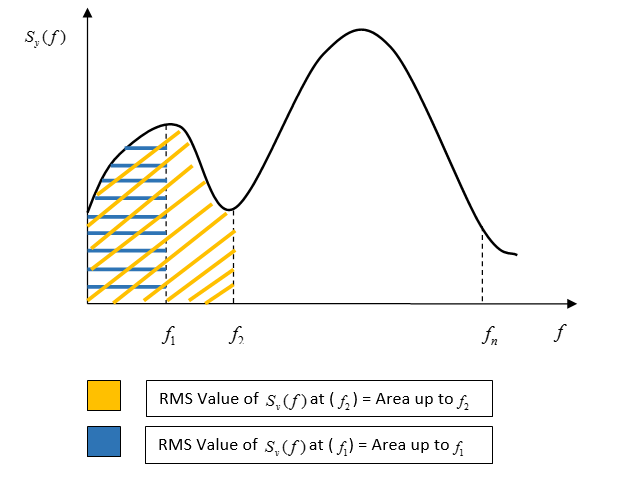
The RANDT1 Bulk Data Entry can be used to specify the lag time (![]() ) used in the calculation of the Auto-correlation function for each response for a particular degree of freedom, “x”.
) used in the calculation of the Auto-correlation function for each response for a particular degree of freedom, “x”.
The auto-correlation function and the power spectral density are Fourier transforms of each other. Therefore, the auto-correlation function of a response Sx( f ) can be described as follows:

The Auto-correlation Function is calculated for each time lag value in the specified RANDT1 set over the entire frequency range [0, fn ].
Random non-deterministic excitation loading on a structure can lead to fatigue failure. The number of fatigue cycles of random vibration is evaluated by multiplying the vibration duration and another parameter called maximum number of positive zero crossing. The maximum number of positive zero crossing is calculated as shown in the following equation:
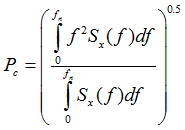
If XYPLOT, XYPEAK or XYPUNCH, output requests are used, the root mean square value and the maximum number of positive crossing calculated at each excitation frequency will be exported to the *.peak file.
Random response analysis is activated, for a particular subcase, through the inclusion of the RANDOM Subcase Information entry in the Subcase, along with the optional ANALYSIS=RANDOM entry. This selector identifies RANDPS and the optional RANDT1 bulk data entries to be used for random response analysis. The complex frequency responses and input spectral density is specified by the RANDPS bulk data entry. The RANDPS data refers to a TABRND1 bulk data entry, which contains the power spectral density of the loading versus frequency. The RANDT1 bulk data entry describes the time span for the auto-correlation. The RCROSS bulk data is used to request the output of the cross-power spectral density function for Random Response Analysis and is referred to by the RCROSS I/O section selector. Loading for each frequency response subcase may be distinct, but all frequency response subcases referenced in a particular Random Subcase should reference the same frequency data.
The RANDT1 bulk data entry describes the time lag set for the calculation of the Auto-correlation function. The RCROSS bulk data is used to request the output of the cross power spectral density function for specific responses from the Random Response Analysis and is referred to by the RCROSS I/O section selector. Loading for each frequency response subcase may be distinct, but frequency response subcases referenced in a particular Random Subcase should reference the same frequency data.
The snippet from a Random Response Analysis Input deck below shows the setup of two different Direct Frequency Response Subcases used to determine the Random Response of the structure. The same Frequency set (FREQUENCY=7) is used for both subcases. Also, Random Response Analysis data (RANDOM=8) and corresponding output sets (DISPLACEMENT=1) are defined in a separate subcase with the optional ANALYSIS RANDOM entry. THE TABRND1 entry is also used to specify the input power spectral density function.
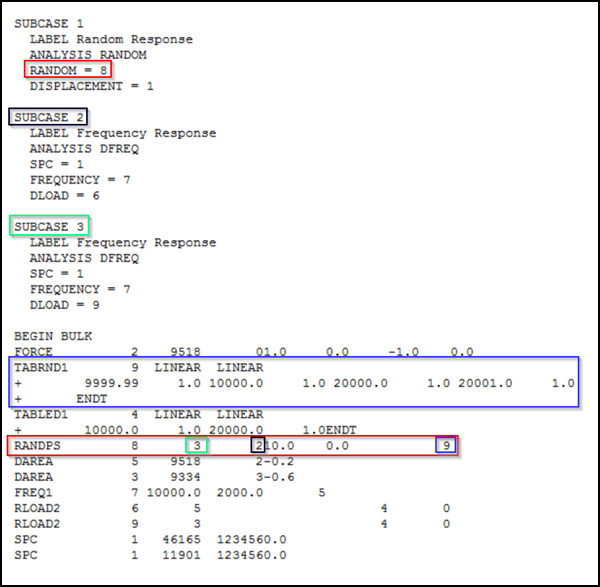
The Random Response Power Spectral Density Function (PSDF) can be written to the .h3d file for DISP, VELO, and ACCE using the PSDF output option on these I/O option data selectors within the Random Subcase. At the end of the output for all the frequencies is the RMS over frequencies output selector in HyperView, as shown below.
The Random Response Power Spectral Density Function (PSDF) can be written to the .h3d file for CBUSH element forces using the FORCE I/O option by specifying the PSDF output option within the Random Subcase. At the end of the output for each frequency is the RMS over frequencies output selector for the .h3d file in HyperView, as shown below.
The Random Response Power Spectral Density Function (PSDF) can be written to the .h3d and .op2 files for solid and shell elements for stress and strain with the STRESS and STRAIN I/O options using the PSDF output option within the Random Subcase. At the end of the output for each frequency is the RMS over frequencies output selector for the .h3d file and the Simulation selector for the .op2 file in HyperView, as shown below.
Additionally, PSDF and RMS von Mises stress and strain results based on the Segalman Method are also written to the .h3d file for Random Response Analysis (only available in the H3D format).
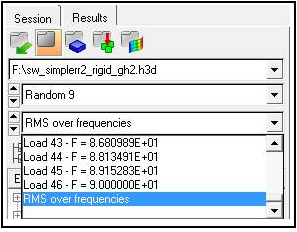
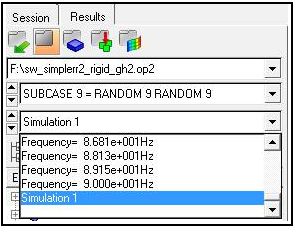
Three plotting output requests may be used for random response analysis results. These output requests are placed in the I/O Options section of the input data. The three plotting controllers are:
Generates a .peak file containing a summary of the requested output. |
|
Generates a HyperGraph session file (_rand.mvw file) and related data file (.rand file) for the requested output. Also generates the .peak file. |
|
Generates a .pch file for the requested output. Also generates the .peak file. |
These output requests are different from most other OptiStruct output requests in that they may be combined on the same line.
The requests are formatted as follows:
| • | "Operation" can be any combination of XYPLOT, XYPUNCH, and XYPEAK. |
| • | "Curve-type" can be FORCE, STRESS, STRAIN, DISP, VELO, or ACCE to request force, stress, strain, displacement, velocity or acceleration, respectively. |
| • | "Plot-type" can be either PSDF or AUTO to request power spectral density function or auto-correlation, respectively. |
| • | "Grid (Component) list" must come after a slash "/". Each entry in the list is comma separated. Each entry consists of a GRID or SPOINT ID followed by a component of motion (T1, T2, T3, R1, R2, or R3) in parentheses. For SPOINTs the component must be T1. |
In addition, plot titles and axis labels may be controlled using TCURVE (plot title), XTITLE (x-axis label), and YTITLE (y-axis label). Default titles and labels are generated when these controls are not used.
Requesting random response results in a HyperGraph session file for the velocity PSDF for GRIDs 3 and 6 for component T2: XYPLOT, VELO, PSDF / 3(T2), 6(T2) |
Requesting random response summary results to be written to the .peak file for the autocorrelation of displacement for GRID 223 for component R3: XYPEAK, DISP, AUTO / 223(T3) |
Requesting random response results output, in all formats, for the acceleration PSDF for GRIDS 8 and 9 for components T1 and T2: XYPEAK, XYPLOT, XYPUNCH, ACCE, PSDF / 8(T1), 9(T1), 8(T2), 9(T2) Here the XYPEAK request is valid, but redundant as it is always created when XYPLOT or XYPUNCH is present. |
Saving and Retrieving Normal Modes Analysis
AMLS (Automatic Multi-Level Sub-structuring) Eigensolver